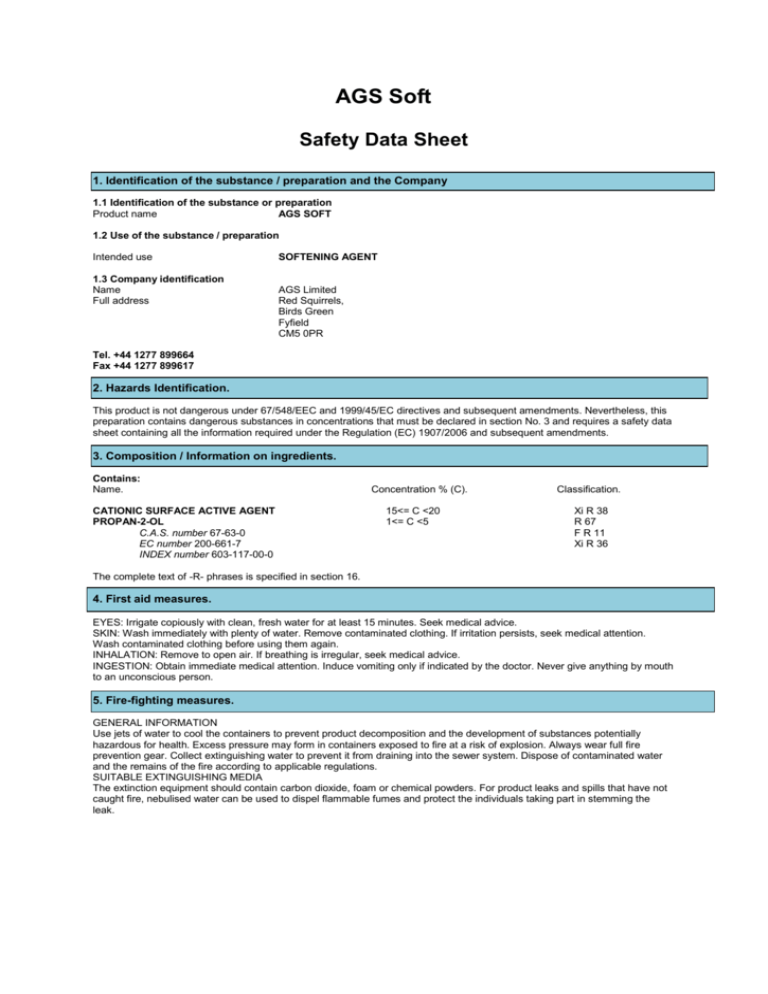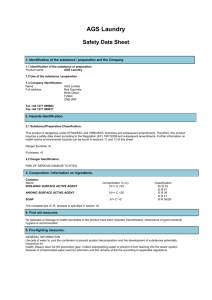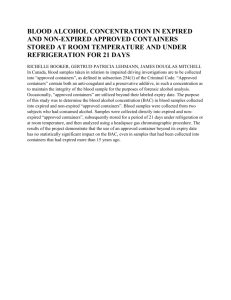View AGS Soft Safety Data Sheets
advertisement

AGS Soft Safety Data Sheet 1. Identification of the substance / preparation and the Company 1.1 Identification of the substance or preparation Product name AGS SOFT 1.2 Use of the substance / preparation Intended use 1.3 Company identification Name Full address SOFTENING AGENT AGS Limited Red Squirrels, Birds Green Fyfield CM5 0PR Tel. +44 1277 899664 Fax +44 1277 899617 2. Hazards Identification. This product is not dangerous under 67/548/EEC and 1999/45/EC directives and subsequent amendments. Nevertheless, this preparation contains dangerous substances in concentrations that must be declared in section No. 3 and requires a safety data sheet containing all the information required under the Regulation (EC) 1907/2006 and subsequent amendments. 3. Composition / Information on ingredients. Contains: Name. CATIONIC SURFACE ACTIVE AGENT PROPAN-2-OL C.A.S. number 67-63-0 EC number 200-661-7 INDEX number 603-117-00-0 Concentration % (C). 15<= C <20 1<= C <5 Classification. Xi R 38 R 67 F R 11 Xi R 36 The complete text of -R- phrases is specified in section 16. 4. First aid measures. EYES: Irrigate copiously with clean, fresh water for at least 15 minutes. Seek medical advice. SKIN: Wash immediately with plenty of water. Remove contaminated clothing. If irritation persists, seek medical attention. Wash contaminated clothing before using them again. INHALATION: Remove to open air. If breathing is irregular, seek medical advice. INGESTION: Obtain immediate medical attention. Induce vomiting only if indicated by the doctor. Never give anything by mouth to an unconscious person. 5. Fire-fighting measures. GENERAL INFORMATION Use jets of water to cool the containers to prevent product decomposition and the development of substances potentially hazardous for health. Excess pressure may form in containers exposed to fire at a risk of explosion. Always wear full fire prevention gear. Collect extinguishing water to prevent it from draining into the sewer system. Dispose of contaminated water and the remains of the fire according to applicable regulations. SUITABLE EXTINGUISHING MEDIA The extinction equipment should contain carbon dioxide, foam or chemical powders. For product leaks and spills that have not caught fire, nebulised water can be used to dispel flammable fumes and protect the individuals taking part in stemming the leak. AGS Soft EXTINGUISHING MEDIA WHICH SHALL NOT BE USED FOR SAFETY REASONS Do not use jets of water. Water is not effective for putting out fires but can be used to cool containers exposed to flames to prevent explosions. HAZARDS CAUSED BY EXPOSURE IN THE EVENT OF FIRE Do not breathe combustion products (carbon oxide, toxic pyrolysis products, etc.). SPECIAL PROTECTIVE EQUIPMENT FOR FIRE-FIGHTERS Hardhat with visor, fireproof clothing (fireproof jacket and trousers with ties around arms, legs and waist) work gloves (fireproof, cut proof and dielectric), self-respirator (self-protector). 6. Accidental release measures. PERSONAL PRECAUTIONS Eliminate sources of ignition (cigarettes, flames, spark, etc.) from the air in which the leak occurred. If there are no contraindications, spray solid products with water to prevent the formation of dust. Use breathing equipment if fumes or powders are released into the air. Block the leakage if there is no hazard. Do not handle damaged containers or leaked product before donning appropriate protective gear. Send away individuals who are not suitably equipped. For information on risks for the environmental and health, respiratory tract protection, ventilation and personal protection equipment, refer to the other sections of this sheet. ENVIRONMENTAL PRECAUTIONS The product must not penetrate the sewers, surface water, ground water and neighbouring areas. METHODS FOR CLEANING UP For liquid products, suck into a suitable container (made of material not incompatible with the product) and soak up any leaked product with absorbent inert material (sand, vermiculite, diatomeous earth, Kieselguhr, etc). Collect the majority of the remaining material and deposit in containers for disposal. For solid products, use spark proof mechanical tools to collect the leaked product and place in plastic containers. If there are no contraindications, use jets of water to eliminate product residues. Make sure the leakage site is well aired. Contaminated material should be disposed of in compliance with the provisions set forth in point 13. 7. Handling and storage. Avoid the accumulation of electrostatic charges. Store the containers sealed and in a well-ventilated place. Vapours may ignite with explosion, it is therefore necessary to avoid accumulation keeping the windows and doors open, ensuring cross ventilation. Without adequate ventilation, the vapours may accumulate at the bottom and ignite at a distance, if triggered off, with the risk of flashback. Keep far away from sources of heat, sparks and bright flames. Do not smoke, use matches or lighters. Keep the containers earthed while decanting and wear antistatic boots. Vigorous stirring and flow through the pipings and equipment may cause the formation and accumulation of electrostatic charges due to the low conductivity of the product. In order to avoid the risk of fire outbreak and explosion never use compressed air during movement. 8. Exposure control / personal protection. 8.1 Exposure limit values. Name Type PROPAN-2-OL TLV-ACGIH OEL WEL Country IRL UK TWA/8h mg/m3 491 ppm 400 400 STEL/15min Mg/m3 982 ppm 500 500 SKIN SKIN SKIN 8.2 Exposure controls. As the use of adequate technical equipment must always take priority over personal protection equipment, make sure that the workplace is well aired through effective local aspiration or bad air vent. HAND PROTECTION Protect hands with category I (ref. Directive 89/686/EEC and standard EN 374) work gloves, such as those in latex, PVC or equivalent. The following should be considered when choosing work glove material: degradation, breakage times and permeation. Work glove resistance to preparations should be checked before use, as it can be unpredictable. Gloves’ limit depends on the duration of exposure. SKIN PROTECTION Wear category I professional long-sleeved overalls and safety footwear (ref. Directive 89/686/CEE and standard EN 344). Wash body with soap and water after removing overalls. RESPIRATORY PROTECTION If the threshold value for one or more of the substances present in the preparation for daily exposure in the workplace or to a fraction established by the company’s prevention and protection service is exceeded, wear a mask with an B or universal filter, the class (1, 2 or 3) of which must be chosen according to the limit concentration of use (ref. standard EN 141).The use of breathing protection equipment, such as masks with organic vapour and dust/mist cartridges, is necessary in the absence of technical measures limiting worker exposure. The protection provided by masks is in any case limited. If the substance in question is odourless or its olfactory threshold is higher than the relative exposure limit and in the event of an emergency, or when exposure levels are unknown or the concentration of oxygen in the workplace is less than 17% volume, wear self-contained, open-circuit compressed air breathing apparatus (ref. standard EN 137) or fresh air hose breathing apparatus for use with full face mask, half mask or mouthpiece (ref. standard EN 138). AGS Soft 3 EYE PROTECTION Use of protective airtight goggles (ref. standard EN 166) recommended. 9. Physical and chemical properties. Colour Odour Appearance Solubility Viscosity Vapour density Evaporation Rate Reactive Properties Partition coefficient: n-octanol/water pH . Boiling point. Flash point. Explosive properties. Vapour pressure. Specific gravity. light blue characteristic liquid soluble in water Not available. Not available. Not available. Not available. Not available. 4 Not available. > 60 °C. Not available. Not available. Not available. 10. Stability and reactivity. The product is stable in normal conditions of use and storage. When heated or in the event of a fire, carbon oxides may be released and vapours which are dangerous to health. The vapours may also form explosive mixtures with the air. 11. Toxicological information. According to currently available data, this product has not yet produced health damages. Anyway, it must be handled carefully according to good industrial practices. This product may have slight health effects on sensitive people, by inhalation and/or cutaneous absorption and/or contact with eyes and/or ingestion. PROPAN-2-OL: oral LD50 (mg/kg) 12800 (RAT); dermal LD50 (mg/kg) 12800 (RAT); inhalation LC50 (rat) 72, 6 mg/l/4h. 12. Ecological information. Use this product according to good working practices. Avoid littering. Inform the competent authorities, should the product reach waterways or sewers or contaminate soil or vegetation. 13. Disposal consideration. Reuse, when possible. Neat product residues should be considered special non-hazardous waste. Disposal must be performed through an authorised waste management firm, in compliance with national and local regulations. CONTAMINATED PACKAGING Contaminated packaging must be recovered or disposed of in compliance with national waste management regulations. 14. Transport information. This product is not dangerous under current provisions of the Code of International Carriage of Dangerous Goods by Road (ADR) and by Rail (RID), of the International Maritime Dangerous Goods Code (IMDG), and of the International Air Transport Association (IATA) regulations. 15. Regulatory information. Warning symbols: None. Hazard sentences (R): None. S2 S 46 KEEP OUT OF THE REACH OF CHILDREN. IF SWALLOWED, SEEK MEDICAL ADVICE IMMEDIATELY AND SHOW THIS CONTAINER OR LABEL. Safety data sheet available upon request for professional users. Danger labelling under directives 67/548/EEC and 1999/45/EC and following amendments and adjustments. AGS Soft 16. Other information. Text of (R) phrases quoted in section 3 of the sheet. R 11 HIGHLY FLAMMABLE. R 36 IRRITATING TO EYES. R 38 IRRITATING TO SKIN. R 67 VAPOURS MAY CAUSE DROWSINESS AND DIZZINESS. GENERAL BIBLIOGRAPHY 1. Directive 1999/45/EC and following amendments; 2. Directive 67/548/EEC and following amendments and adjustments (technical adjustment XXIX); 3. Regulation (EC) 1272/2008 (CLP) of the European Parliament; 4. Regulation (EC) 1907/2006 (REACH) of the European Parliament; 5. The Merck Index. - 10th Edition; 6. Handling Chemical Safety; 7. Niosh - Registry of Toxic Effects of Chemical Substances; 8. INRS - Fiche Toxicologique (toxicological sheet); 9. Patty - Industrial Hygiene and Toxicology; 10. N.I. Sax - Dangerous properties of Industrial Materials-7, 1989 Edition; Note for users: The information contained in the present sheet is based on our own knowledge on the date of the last version. Users must verify the suitability and thoroughness of provided information according to each specific use of the product. This document must not be regarded as a guarantee on any specific product property. The use of this product is not subject to our direct control; therefore, users must, under their own responsibility, comply with the current health and safety laws and regulations. The producer is relieved from any liability arising from improper uses. Changes to previous review. The following sections were modified: 16




